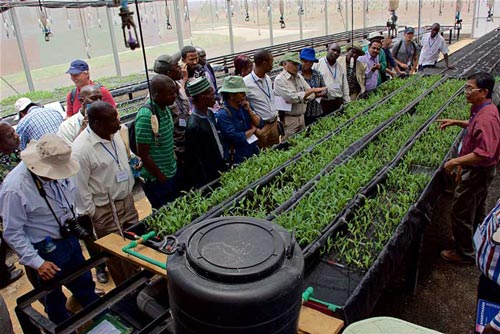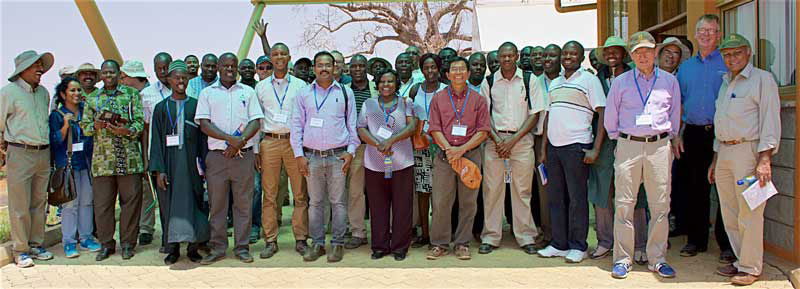
Two words – accelerated breeding – are synonymous to doubled-haploid (DH) based maize breeding. This was the core message shared with 56 maize breeders from 10 African countries who recently participated in a two-day training workshop organized by CIMMYT’s Global Maize Program (GMP) in Nairobi, Kenya, from September 23–24, 2015. The breeders benefited from the knowledge and experience of resource persons from public and private institutions in France, Germany and USA who have dedicated years of research on the DH technology that is changing the pace of maize breeding.
The resource persons for the training workshop included Tim Cupka (AgReliant Genetics, USA), Thomas Lubberstedt (Iowa State University, USA), Wolfgang Schipprack (University of Hohenheim, Germany), Dominic Marc and Regis Brassart (Limagrain, France), and CIMMYT’s B.M. Prasanna, Vijay Chaikam, Yoseph Beyene and Sotero Bumagat.
The DH technology shortens the breeding cycle significantly by developing 100 percent homozygous lines within 2–3 seasons compared to conventional breeding that takes at least 7–8 seasons to develop inbred lines with 98–99 percent homozygosity. While tracing the evolution of DH technology in maize, B.M Prasanna, Director of both GMP and the CGIAR Research Program MAIZE remarked, “This is a significant reduction of time, labor and important resources. There is a great opportunity for maize breeders in Africa to modernize the breeding programs using DH technology, coupled with molecular markers. It is particularly important to enhance genetic gains while effectively dealing with an array of stresses crippling maize production in sub-Saharan Africa.”
While commercial seed industries across the world have benefited significantly from this technology, the uptake among the institutions of the national agricultural research systems (NARS) and the small- and medium-scale enterprise (SME) seed companies in sub-Saharan Africa (SSA) is significantly low. This is due to various reasons, particularly lack of awareness about the power of DH technology.
To address this challenge, CIMMYT in partnership with Kenya Agricultural and Livestock Research Organization (KALRO) established the maize DH facility – the first of its kind in SSA – at the Kiboko Maize Research Station in Kenya in September 2013. The facility offers DH development service to NARS and SME seed companies – with financial support from Bill & Melinda Gates Foundation.
“Establishing and operating such a facility requires significant technical know-how and is not an easy task,” said Prasanna. “It is more practical for our NARS and SME seed company partners to utilize the facility at Kiboko to develop DH lines with diverse genetic backgrounds through the DH development service offered by CIMMYT, make effective selections, and use well-selected DH lines in hybrid breeding programs. The purpose of the training workshop is to make breeders aware of the tremendous opportunities to integrate DH lines in maize breeding programs”.
Sure-footed progress – Africa’s maize breeding on the right path
It is estimated that about 70 to 80 percent of new maize hybrids being produced currently by major seed companies in the world, especially in North America and Europe, contain one or more doubled-haploid lines, with DH-based maize hybrids covering about 40 to 50 million hectares worldwide.
Tim Cupka, a highly experienced maize breeder at AgReliant Genetics, USA, emphasized that DH technology has changed the face of maize breeding in his organization. “The developed world is intensively practicing DH-based maize breeding. There is so much value that can be created through this technology not just for public and private maize breeding programs and seed companies in Africa, but ultimately for the farmers,” noted Tim.
For farmers and breeders, the greatest value is that DH technology reduces the amount of time (by one-third) it takes to create new commercial hybrids. “Instead of taking 12 years to develop a superior hybrid, we are now developing new hybrids within 6 to 7 years, which means we can get superior genetics to the farmers much faster than ever before! This is key to strengthening the livelihood of millions of farmers across the world. That is our success as breeders,” Tim concluded.
GMP in Africa has effectively integrated DH and molecular marker technologies in its product development pipeline. More than 92,000 DH lines have been developed so far from CIMMYT bi-parental populations at the DH facilities at Kiboko and Agua Fria, Mexico. In addition, significant contributions have been made over the last few years by Monsanto and DuPont Pioneer in developing DH lines in CIMMYT’s Africa-adapted maize genetic backgrounds through the Water Efficient Maize for Africa and Improved Maize for African Soils projects. “CIMMYT has so far released 32 DH-based maize hybrids in Kenya, Uganda, Tanzania, and South Africa between 2012 and 2015.These hybrids showed excellent performance under optimum, drought and low-nitrogen stress conditions,” reported Yoseph Beyene, a CIMMYT Maize Breeder based at Nairobi, Kenya. He also added that the five DH lines have been recently identified for release as CIMMYT maize lines.
In addition, more than 5,000 DH lines have been screened by CIMMYT for maize lethal necrosis (MLN) disease under artificial inoculation at the MLN Screening Facility at Naivasha, Kenya; promising lines have been identified offering tolerance to the disease. Therefore, DH technology can be a powerful tool to accelerate development of MLN-tolerant maize hybrids for sub-Saharan Africa.
Participants at the workshop got an opportunity to visit the DH facility at Kiboko in Makueni County, Kenya, where they saw the DH breeding process. The tour was facilitated by Sotero Bumagat, Maize DH Facility Manager, CIMMYT–Kenya. “This is a new experience and a very enriching one,” remarked Lwanga Kasozi from the Agricultural Research Institute in Tanzania. “I have seen and understood DH-based breeding both in theory as well as practice. It is my desire to see our organization in Tanzania embrace this technology. I will play my part to share this experience and knowledge.”.

The Alliance for a Green Revolution in Africa (AGRA), also nominated its scientists to participate in the training workshop. In addition, AGRA sponsored the participation of nine maize breeders from different NARS institutions in SSA to participate in the workshop.
 Nutrition, health and food security
Nutrition, health and food security 
